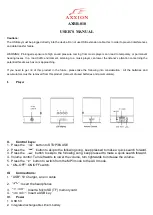
TP-7045 3/18c
17
Section 4 Exhaust System
Section 4 Exhaust System
Carbon monoxide.
Can
cause
severe
nausea,
fainting, or death.
The exhaust system must be
leakproof and routinely inspected.
WARNING
Carbon monoxide symptoms. Carbon monoxide can
cause severe nausea, fainting, or death.
Carbon monoxide
is a poisonous gas present in exhaust gases. Carbon
monoxide is an odorless, colorless, tasteless, nonirritating gas
that can cause death if inhaled for even a short time. Carbon
monoxide poisoning symptoms include but are not limited to
the following:
D
Light-headedness, dizziness
D
Physical fatigue, weakness in
joints and muscles
D
Sleepiness, mental fatigue,
inability to concentrate
or speak clearly, blurred vision
D
Stomachache, vomiting, nausea
If experiencing any of these symptoms and carbon monoxide
poisoning is possible, seek fresh air immediately and remain
active. Do not sit, lie down, or fall asleep. Alert others to the
possibility of carbon monoxide poisoning. Seek medical
attention if the condition of affected persons does not improve
within minutes of breathing fresh air.
Inspecting the exhaust system. Carbon monoxide can
cause severe nausea, fainting, or death.
For the safety of
the craft’s occupants, install a carbon monoxide detector.
Never operate the generator set without a functioning carbon
monoxide detector.
Inspect the detector before each
generator set use.
Operating the generator set. Carbon monoxide can cause
severe nausea, fainting, or death.
Be especially careful if
operating the generator set when moored or anchored under
calm conditions because gases may accumulate. If operating
the generator set dockside, moor the craft so that the exhaust
discharges on the lee side (the side sheltered from the wind).
Always be aware of others, making sure your exhaust is
directed away from other boats and buildings.
Note:
Do not use copper tubing in diesel exhaust
systems. Sulfur in diesel exhaust causes rapid
deterioration of copper tubing exhaust systems,
resulting in exhaust/water leakage.
4.1 Types
Kohler
r
generator sets covered in this manual use
either wet or dry exhaust systems. Dry exhaust systems
are common in commercial applications. See the
engine manual for specifications.
4.2 Exhaust Lines
Use water-cooled exhaust lines in all marine
installations. Keep the lines as short and straight as
possible.
NFPA 302 Fire Protection Standard for
Pleasure and Commercial Motor Craft, Clause 4-3,
recommends using two corrosion-resistant hose
clamps with a minimum width of 13 mm (1/2 in.) on each
end of the flexible exhaust hose connections.
Kohler Co. requires a downward pitch of at least 13 mm
per 30.5 cm (1/2 in. per running foot). Use a flexible
exhaust hose that conforms to UL Standard 1129 for the
engine’s wet exhaust components between the mixer
elbow and the exhaust outlet.
Содержание 12EFKOZD
Страница 2: ...TP 7045 3 18c 2...
Страница 8: ...TP 7045 3 18c 8 Safety Precautions and Instructions Notes...
Страница 12: ...TP 7045 3 18c 12 Section 2 Location Lifting and Mounting Notes...
Страница 24: ...TP 7045 3 18c 24 Section 4 Exhaust System Notes...
Страница 28: ...TP 7045 3 18c 28 Section 5 Fuel System Notes...
Страница 34: ...TP 7045 3 18c 34 Section 6 Electrical System Notes...
Страница 50: ...TP 7045 3 18c 50 Section 7 Installation Drawings Notes...
Страница 54: ...TP 7045 3 18c 54 Section 8 Reconnection Figure 8 3 Generator Reconnection ADV 5875F U...
Страница 81: ...TP 7045 3 18c 81...
Страница 82: ...TP 7045 3 18c 82...
Страница 83: ...TP 7045 3 18c 83...
















































